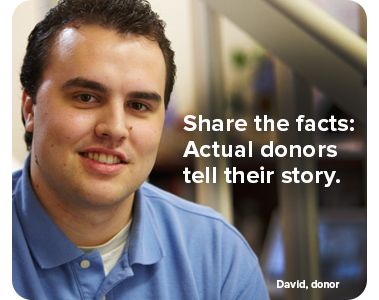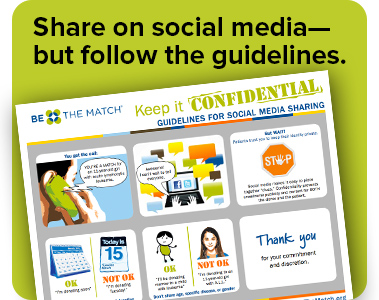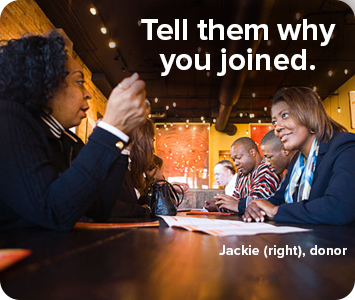Javascript disabled. This site requires JavaScript How to enable JavaScript.
You are using an outdated browser. Please upgrade your browser to improve your experience.

Our name has changed but our mission has not: We save lives through cell therapy. Learn more
Commonly asked questions

Share the facts: Actual donors tell their story
Watch videos from actual donors to learn more about the donation experience.
Share on social media
Share with care! Follow the guidelines for social media sharing
The questions below are some of the most commonly asked questions from friends and other supporters of potential donors like you. Click on each question to display the suggested responses and use the information to prepare yourself for your conversation.
You can also print this toolkit (PDF).
Donation basics
What did you join?
- I joined the Be The Match Registry®, the world’s most diverse of volunteer marrow donors. I am one of more than 9 million people on the registry.
- Be The Match matches volunteer donors like me with thousands of patients with blood cancers like leukemia and lymphoma, sickle cell anemia or other life-threatening diseases.
- For many people with blood cancers like leukemia and lymphoma, and other life-threatening diseases, a marrow transplant may be the best treatment option that could save their life.
Conversation tip: Tell your friends where and why you joined the registry in the first place. Did you have a friend who needed a transplant? Did you hear about the strong need for donors from diverse racial and ethnic communities? This might help them understand your motivation.
How does a marrow transplant work?
- First, patients undergo chemotherapy and sometimes radiation to destroy their diseased marrow. Then the donor’s healthy blood-forming cells are given to the patient, where they can begin to function and multiply.
- For a patient’s body to accept these healthy cells, the patient needs a donor who is a close match based on their human leukocyte antigen (HLA) type.
Why do you want to donate?
- I decided to join the registry and pledged to donate to any searching patient. I can help give a patient a second chance at life.
- Seventy percent of patients don’t find a match within their own family and depend on Be The Match to find a donor. Imagine if someone in your family needed a transplant and couldn’t find a match.
- I’ve been identified as a possible match for a patient. If I’m found to be the best match for the patient, I will be asked to donate. Identities are kept confidential to protect both the donor and the patient, so I have limited information about the patient.
- Matching a patient is more complex than simply matching blood types. I could be the only person on the registry that can help this patient. Doctors match donors and patients based on many factors, the most important being their human leukocyte antigen (HLA) type. HLA are proteins – or markers – found on most cells in the body. Because the markers are inherited, patients are more likely to match someone of similar heritage.
Conversation tip: Tell your friends and other supporters specifically why you want to help this patient and how much it means to you. The best answer to this question is your personal motivation for donating.
How do you donate marrow?
There are two methods of donation: peripheral blood stem cell (PBSC) and bone marrow. The patient’s doctor chooses the donation method that is best for the patient.
PBSC donation is a nonsurgical procedure that takes place at a blood center or outpatient hospital facility that is experienced and participates in PBSC collections for Be The Match.
- For five days leading up to donation, I will be given injections of a drug called filgrastim to increase the number of blood-forming cells in my bloodstream.
- My blood will be removed through a needle in one arm and passed through a machine that separates out the blood-forming cells. The remaining blood is returned to me through the other arm. This process is called apheresis.
- This method of donation is similar to the method used for plasma donation. However, PBSC donation typically takes longer than a plasma donation. If I donate in one day, it could take up to eight hours. If I donate over the course of two days, it will take 4-6 hours each day.
- After donation, my collected cells are then transported to the patient’s location for transplant.
Marrow donation is a surgical outpatient procedure that takes place in a hospital operating room.
- I will receive anesthesia and feel no pain during the donation.
- Doctors use a needle to withdraw liquid marrow from both sides of the back of my pelvic bone.
- The marrow replaces itself completely within 4-6 weeks.
- After donation, my collected cells are then transported to the patient’s location for transplant.
Time and cost
Do you get paid to donate?
- No. People join the registry and donate because they want to help others in need, regardless of compensation.
How much time is this going to take out of your life?
- The time commitment for the donation process is generally 20-30 hours over a 4-6 week period. I will have a few different appointments including a physical exam to ensure I’m healthy enough to donate.
Will you need to travel?
- I may be asked to travel for the donation or any of the steps of the donation process. Nearly 40 percent of donors travel by air and stay one or more nights in a hotel.
- To ensure that the procedure is safe for donors, Be The Match only works with hospitals and facilities that are experienced in collecting marrow or PBSC, so if there is not a facility near me, I may need to travel.
- I will not be traveling to the patient’s location for donation. My cells are transported to the patient’s location right after my donation.
Do you have to pay to donate?
- No. Be The Match covers medical and travel expenses. The only cost to me might be time taken off from work.
Health concerns
Does marrow donation hurt? It sounds pretty scary.
- There are two methods of donation: PBSC donation is an outpatient procedure that takes place at a blood center or hospital and marrow donation is done in a hospital operating room and anesthesia is used. Both ways of donating are designed so they are as comfortable and safe for me as possible.
- I’ve learned that there can be uncomfortable but short-lived side effects of donating PBSC. Due to taking a drug called filgrastim for five days leading up to donation, PBSC donors may have headaches, joint or muscle aches, or fatigue. PBSC donors are typically back to their normal routine in 1-2 days.
- I’ve learned that those donating marrow receive general or regional anesthesia, so they feel no pain during donation. Marrow donors can expect to feel some soreness in their lower back for 1-2 weeks afterward. Most marrow donors are back to their normal activities in a few days.
Conversation tip: Encourage others to visit our donor testimonial library to watch past donors talk about their experience. These videos will help eliminate the myths your friends have about the donation procedure.
How long will it take you to recover?
- I’m expecting to return to work, school and most other activities within 1-7 days after donation.
- Most PBSC donors report that they feel completely recovered within one week of donation.
- Most marrow donors report that they feel completely recovered within three weeks of donation.
Support
What can I do to help you while you’re going through the donation process?
- Donation requires several appointments and a time commitment. I might need your help in a lot of different ways like rides to appointments or help taking care of my kids, pets or home. I may also want someone to talk with since this can be an emotional experience.
How can I get involved with Be The Match?
- You can spread the word about donation. For people with life-threatening blood cancers like leukemia and lymphoma or other diseases, a cure exists. Help make sure every patient gets the transplant they need by making a contribution or joining the registry.
- You can also host a recruitment drive to encourage others to join the registry. Fill out the online form and someone from Be The Match will contact you.
I don’t think my cultural/religious beliefs support marrow donation.
- I understand religious and cultural beliefs play an important role in our lives. However, most religious and cultural groups support donation.
- I encourage you to research donation and have a conversation with your religious leader to see if joining the marrow registry is right for you.